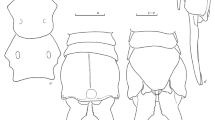Abstract
The new genusTervidmonea (type-species:T. daniensis n.gen. n.sp., ? Fam. Terviidae) is described from the Baltic Danian, from Danian ‘Geschiebe’ (glacial erratic drift material) of Northern Germany, from the Upper Maastrichtian of the Maastricht region, and from the Palaeogene ‘Nummuliten-Mergel’ of Bavaria. The zoarium is erect (‘ldmoneiform’), with alternating uniserial fascicles on the frontal side, as inExidmonea David et al. The dorsal face lacks kenozooids and bears a prominent globular ovicell (gynozooid), by which it differs from the genusTervia Jullien 1882. Certain taxa from the Eocene of the U.S.A. referred toTervia by Canu & Bassler (1920) are considered as congeneric withTervidmonea: T. tumida Smitt,T. globulifera Canu & Bassler, andT. pyrifera Canu & Bassler. However, the identity with the RecentTervia tumida from the Arctic realm remains doubtful and so does the present-day occurrence ofTervidmonea.
Kurzfassung
Aus dem baltischen Danium und aus Danium-Geschieben Norddeutschlands, aus dem Ober-Maastrichtium der Grube Curfs b. Maastricht sowie dem lutetischen Nummuliten-Mergel des Rollgrabens/Bayern wird die neue GattungTervidmonea (Typusart:T. daniensis n.gen. n.sp., ? Fam. Terviidae Jullien) beschrieben. Wuchsform: Zoarium erekt (‘idmoneiform’), Aperturae frontal in kurzen alternierenden Faszikeln angeordnet wie beiExidmonea David et al. Dorsalseite glatt, frei von Kenozooecien, mit charakteristischer globulärer Ovicelle (Gynozooid). Die ansonsten sehr ähnlicheTervia Jullien ist durch eine länglich-flache Ovicelle eindeutig unterschieden. Taxa aus dem Eozän Jacksonian) der U.S.A., von Canu & Bassler (1920) zuTervia gestellt, erweisen sich als kongenerisch:T. tumida Smitt,T. globulifera Canu & Bassler undT. pyrifera Canu & Bassler. Die Identität mit der rezenten arktischenT. tumida Smitt und mithin rezentes Auftreten der GattungTervidmonea bleiben ungewiß.
Similar content being viewed by others
Literatur
Bassler, R. S. 1953. Bryozoa. [In:]Moore, R. C. (ed.) Treatise on Invertebrate Paleontology, Part G: G1-G253,175 Abb. - New York (Geological Society of America) und Lawrence, Kansas (University of Kansas).
Cano, F. &Bassler, R.S. 1920. North American Early Tertiary Bryozoa. - United States National Museum, Bulletin106: 1–879, 162 Taf., 279 Abb., Washington, D.C.
David, L.;Mongereau, N. &Pouyet, S. 1972. Bryozoaires du Néogène du bassin du Rhône. Gisements burdigaliens de Mus (Gard). - Documents des Laboratoires de Géologie de la Faculté des Sciences de Lyon52: 1–118, 12 Taf., 1 Abb., Lyon.
Gregory, J. W. 1899. Catalogue of the fossil Bryozoa in the Department of Geology, British Museum (Natural History). The Cretaceous Bryozoa.1: i-xiv + 1-457, 17 Taf., 64 Abb., London.
Harmelin, J.-G. 1976. Le sous-ordre de Tubuloporina (Bryozoaires Cyclostomes) en Méditerranée. -Mémoire Institut Océanographique10: 1–326, 38 Taf., 50 Abb., Monaco.
Johnston, G. 1838. A history of British zoophytes. - i-xii + 1–342,44 Taf., Edinburgh, London. [1st edition]
Jullien, J. 1882. Dragages du ‘Travailleur’-Bryozoaires - espèces draguées dans l’Océan Atlantique en 1881. - Bulletin de la Société Zoologique de France7: 457–529, Taf. 13–17, Paris.
Kluge, G. A. 1975. Bryozoa of the northern Seas of the USSR. - i-xxiii, 1–711, 404 Abb., Smithsonian Institution & National Science Foundation New Delhi (Amerind Publ.). [Übersetzung v. Kluge, G. A. 1962. Mshanki Severnykh Morei SSSR. - Zoologicheskim Institutom, Akademii Nauk SSSR76, Moskau.]
Mongereau, N. 1969. Le genreIdmonea Lamouroux, 1821 (Bryozoa-Cyclostomata) dans le Tertiaire d’Europe. -Geobios2: 205–264, 1 Taf., 4 Abb., Lyon.
Orbigny, A. d’. 1851–1854. Paléontologie française. Terrains crétacées. Tome5, Bryozoaires. - Texte et Atlas: 1–188, Taf. 600–683 [1851]; 189–472, Taf. 684–761 [1852]; 473–984, Taf. 762–800 [1853]; 985–1192 [1854], Paris.
Schäfer, P. 1991. Brutkammern der Stenolaemata (Bryozoa): Konstruktionsmorphologie und phylogenetische Bedeutung. -Courier Forschungs-Institut Senckenberg136: 1–263, 56 Taf., 76 Abb., Frankfurt/M.
Smitt, F. A. 1871. Kritisk förteckning öfver Skandinaviens Hafsbryozoer. - Öfversigt af Kongl. Vetenskaps-Akademiens Förhandlingar9: 1115–1134, Taf. 20–21, Stockholm.
Taylor, P.D. &Voigt, E. 1992. Taxonomic status of the cyclostome bryozoan genusExidmonea, with a redescription ofE. dorsata (von Hagenow) from the Upper Cretaceous. - Verhandlungen des naturwissenschaftlichen Vereins Hamburg, neue Folge33: 121–130, 5 Abb., 1 Taf., Hamburg.
Waters, A.W. 1904. Bryozoa from Franz-Josef Land, collected by the Jackson-Harmsworth Expedition, 1896–1897. Pt. II. Cyclostomata, Ctenostomata, and Endoprocta. - Journal of the Linnéan Society-Zoology,29 (No. 109): 161–184, Taf. 19–21, London.
Author information
Authors and Affiliations
Rights and permissions
About this article
Cite this article
Voigt, E., Eiserhardt, K.H. Tervidmonea n.gen. (Bryozoa, Cyclostomata) aus dem Paläogen Mitteleuropas. Paläontol. Z. 69, 417–427 (1995). https://doi.org/10.1007/BF02987804
Received:
Accepted:
Issue Date:
DOI: https://doi.org/10.1007/BF02987804




